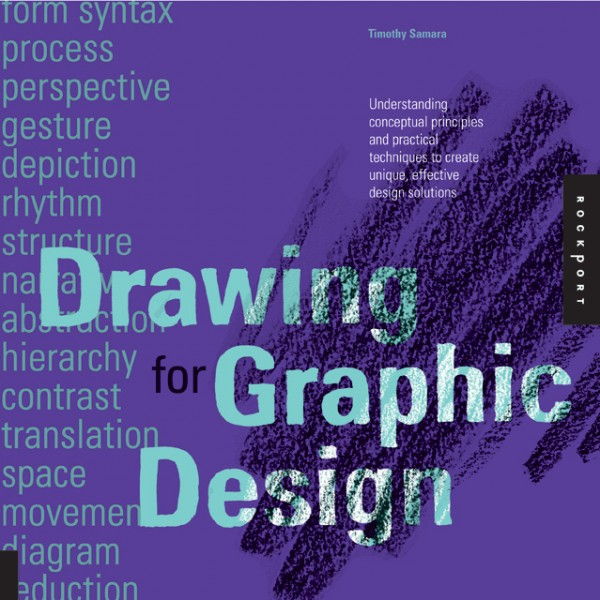Drawing for Graphic Design: Understanding Conceptual Principles and Practical Techniques to Create Unique, Effective Design Solutions
ISBN: 9781592537815
Finally a book that talks about design development rather than finished designs! Drawing for Graphic Design: Understanding Conceptual Principles and Practical Techniques to Create Unique, Effective Design Solutions by Timothy Samara and published by Rockport is a theoretical and instructional book on how to be a successful design drawers. Professional designers known what I am talking about when I say that design drawing is a very different skill than designing for art. There are very different brain processes that are working and being triggered, and likewise the way in which the drawing is constructed and realised on paper is also different, similar but ultimately different.
Before you even touch the hundreds and thousand of portfolio books out there zapping through their wondrous finished glaze, consider getting a book that will help you think better and help you design better. Although I can’t say this as a blanket rule but designing straight on the computer is not the best way to design! Get your design juices flowing, change and manipulate your designs rapidly, change the ambiguity or preciseness of your concept with a touch of a hand.
The title is split up into 4 general sections which include:
Discovery – This sections introduces the reader to design and visual language. It begins with a brief history of drawing and then steps into topics like composition, type, pictorials, language and tone, images/photographs, colour, patterns and structure, volume and space, symmetry, relationships, negatives/positives, depth, subject selection, manipulation, message, must I go on any further! As you can see this section covers a lot with a couple of pages being dedicated to each topic, all contain relevant diagrams and examples.
Processes – Processes introduces the reader to various design processes and methodologies for achieving your envisaged design. Processes kicks off with of course the design process! The great question, “where should you begin?” is answered as the chapter guides you through the typical design process from ideation through to development, testing and refinement. I think there is nothing more fascinating than watching designers develop their concepts, it’s like peering into the designers mind for a few moments. The section even has a case study which shows a real world projects development from sketches through to computer idealisation. The section also covers issues relating to whether your work will be printed, digital and integrating drawing with other kinds of imagery.
Invention – Invention is the real practical side of Drawing for Graphic Design as it equips you, the designer, with the right tools and techniques to get the job done. Starting off with of course with different types of pencils and instruments like rulers, right angled rules, scalpels, erasers, paints etc. etc. It then tackles issues like construction lines, and line thickness and depth, drawing in perspective and drawing organic shapes. This is a really great practical guide!
Artefacts – Artefacts is like the icing on the cake which shows real world examples of all these lessons applied to interesting and challenging projects. The final designs are beautiful and make you admire the ingenuity and technical skill of graphic artists.
Whether you are in the graphics or industrial design industry or even architecture and interior design the lessons can be equally applied. However don’t expect hundreds of pages of rendered car designs or furniture, this may bother some but it certainly doesn’t disbar me. It would be nice if the book hit on some more creative brain storming techniques, that is, how do you actually come up with better designs, which would certainly be a great follow up/prequel to Drawing for Graphic Design. The book really focuses on the “how do I draw” question more than the “how do I design” question which is really a different but indirectly related beast.
Drawing for Graphic Design is a comprehensive reference for students and professionals of all development levels. The author Timothy Samara delicately presents arguments in a suggestive rather than blanket-rule manner as design drawing can be used in so many different ways depending on the individual. Although Drawing for Graphic Design would be classed as an instructional book it is fantastically presented, it satisfies the keen learner with lots of information whilst still keeping the level of diagrams and illustrative examples frequent and engaging.
The layout is very dynamic, don’t expect every page to look the same and this is how a good instructional book should be. Every page layout has been thoughtfully designed to optimise the impact of the main message trying to be portrayed. You will witness designs at all stages of development, using a variety of mediums and instruments and it features examples in many different industries and design types (e.g. logos, brochures, symbols, typography etc.). Sometimes I think I am being a little too generous when I hand out the rare 5 stars, but this book has it all: great teachings, great structure, great presentation, great designs and a good mixture of portfolio pieces, text, case studies and diagrams.
[rating:5]



